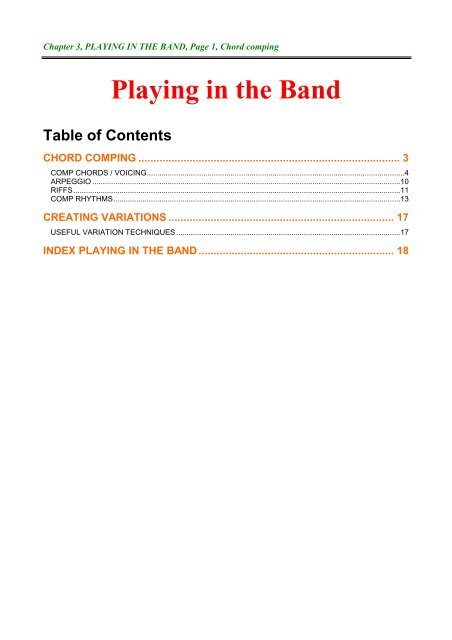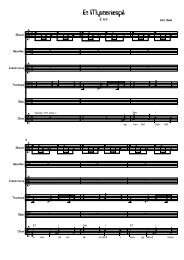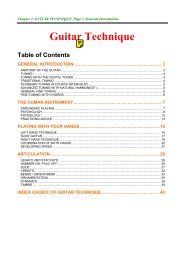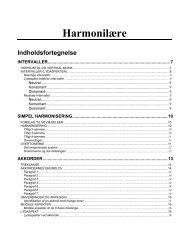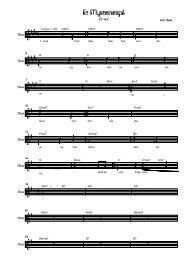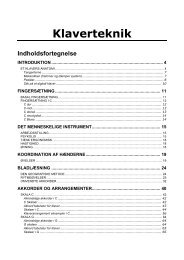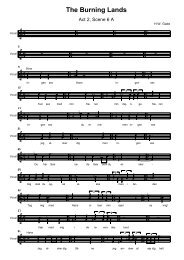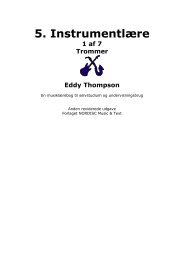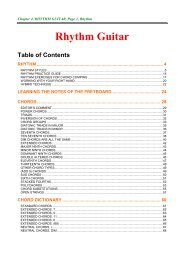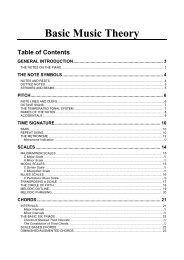Chapter 3, PLAYING IN THE BAND, Page 1 - NORDISC Music & Text
Chapter 3, PLAYING IN THE BAND, Page 1 - NORDISC Music & Text
Chapter 3, PLAYING IN THE BAND, Page 1 - NORDISC Music & Text
Create successful ePaper yourself
Turn your PDF publications into a flip-book with our unique Google optimized e-Paper software.
<strong>Chapter</strong> 3, <strong>PLAY<strong>IN</strong>G</strong> <strong>IN</strong> <strong>THE</strong> <strong>BAND</strong>, <strong>Page</strong> 1, Chord comping<br />
Table of Contents<br />
Playing in the Band<br />
CHORD COMP<strong>IN</strong>G ....................................................................................... 3<br />
COMP CHORDS / VOIC<strong>IN</strong>G ...........................................................................................................................4<br />
ARPEGGIO ...................................................................................................................................................10<br />
RIFFS ............................................................................................................................................................11<br />
COMP RHYTHMS .........................................................................................................................................13<br />
CREAT<strong>IN</strong>G VARIATIONS ........................................................................... 17<br />
USEFUL VARIATION TECHNIQUES ...........................................................................................................17<br />
<strong>IN</strong>DEX <strong>PLAY<strong>IN</strong>G</strong> <strong>IN</strong> <strong>THE</strong> <strong>BAND</strong> ................................................................. 18
<strong>Chapter</strong> 3, <strong>PLAY<strong>IN</strong>G</strong> <strong>IN</strong> <strong>THE</strong> <strong>BAND</strong>, <strong>Page</strong> 2, Chord comping<br />
All Aspects of ROCK & JAZZ<br />
Volume 3 – The Electric Guitar<br />
Playing in the Band 3 of 7 Documents<br />
ISBN 87-88619-68-0<br />
1st Edition, 1st Issue<br />
Summer 2000 Produced in Denmark<br />
Digital Books is a trademark of<br />
<strong>NORDISC</strong> <strong>Music</strong> & <strong>Text</strong>, Ryparken 6, 1. th., Copenhagen 2100 Kbh. Ø<br />
www.nordisc-music.com<br />
<strong>Text</strong>, notes and musical examples:<br />
© Copyright Sebastian Kalamajski 2000<br />
Editor, Illustrations, layout and concept, additional text<br />
Orchestra arrangements, rock musical examples:<br />
© Copyright H.W. Gade 1981-84/2000<br />
All rights reserved. Copying or reproduction in full/in extension not allowed. No public hire of the material<br />
allowed without the written permission of the publishing house.
<strong>Chapter</strong> 3, <strong>PLAY<strong>IN</strong>G</strong> <strong>IN</strong> <strong>THE</strong> <strong>BAND</strong>, <strong>Page</strong> 3, Chord comping<br />
Chord comping<br />
Comping (accompanying) other musicians in a jazz or rock band requires a lot of<br />
listening from your side. <strong>Music</strong> will flow nicely if you hear what other players are<br />
doing and try to complete and fresh up the rhythm, yet without too much<br />
engagement, which would only distract the listeners and make the other musicians<br />
angry. What you probably are aware of is the fact that you must be able to follow the<br />
rhythm of music fluently and with no uncertainty. This ability alone will make you a<br />
better rhythm guitarist, because you will instinctively learn how and when to assist<br />
your band with a well balanced rhythmic playing.<br />
If you already practice the rhythm exercises in chapter 4, you are on your way to developing this<br />
wonderful ability to cooperate rhythmically with other musicians. These exercises are designed to<br />
teach you the most usual (and even some unusual) rhythm figures used in music. When you play<br />
them for some months or even years, they will become a part of your instinctive rhythm vocabulary,<br />
and you will be able to automatically incorporate them in your playing style. Not bad!<br />
Read on and learn some comping techniques applicable for band playing.<br />
Fig. 1 Comping with the band
<strong>Chapter</strong> 3, <strong>PLAY<strong>IN</strong>G</strong> <strong>IN</strong> <strong>THE</strong> <strong>BAND</strong>, <strong>Page</strong> 4, Chord comping<br />
Comp Chords / Voicing<br />
JAZZ Comping With Small Voicings When a soloist is playing, you do not want to get in<br />
his/her way too much, and it can be good to lay back and comp with just two or three notes of a<br />
chord. The notes you choose should be definitive notes. What are they? These are the notes that<br />
define the type of the chord. For a maj7 chord it is the major third and major seventh. For a<br />
min7 chord it is the minor third and minor seventh. For dominant chord it is the major third and<br />
minor seventh. Altered notes and chord extensions can be added to these notes with great effect,<br />
because they tell us what chord is in use for the moment. Usually the root and perfect fifth of<br />
the chord are omitted. These are often played by bass or keyboard players. Here is an example<br />
of comping with definitive notes:<br />
Fig. 2<br />
Comping with Definitive Notes<br />
Notes<br />
3compdef.PDF<br />
Tablature<br />
3compjazz_tab.PDF<br />
Listen to the Notes<br />
ZOOM FUNCTION To zoom in on the notes and TABs, which often appear blurred on the<br />
screen, click the hyperlink of the notes or TAB to see the illustration in max resolution.<br />
When you need to print the notes/TABs, always print the ZOOM view for best results.
<strong>Chapter</strong> 3, <strong>PLAY<strong>IN</strong>G</strong> <strong>IN</strong> <strong>THE</strong> <strong>BAND</strong>, <strong>Page</strong> 5, Chord comping<br />
ROCK Comping Example The comping activities in rock music are normally carried out by<br />
one or more rhythm guitars or keyboards. As solo playing is limited to the occasional lead<br />
guitar or sax, a thorough knowledge of the ways jazz musicians comp the soloists is not that<br />
important to the rock guitar player. A couple of possible rock comping follows:<br />
Fig. 3<br />
Comping Example in Rock<br />
Notes<br />
3comprck.PDF<br />
Tablature<br />
3comprock_tab.PDF<br />
Listen to the Notes
<strong>Chapter</strong> 3, <strong>PLAY<strong>IN</strong>G</strong> <strong>IN</strong> <strong>THE</strong> <strong>BAND</strong>, <strong>Page</strong> 6, Chord comping<br />
JAZZ Fourth Stacks These voicings has a very special sound, and can spice up the music<br />
when you use them the right way. Stacked fourths are simply combinations of notes stacked<br />
above each other by the interval of fourth. For comping, it is wise to use a combination of two<br />
or three such notes, to not disturb the music itself. A three note stacked fourth can be used in at<br />
least three ways: based on the root of a minor11 chord (which means you will play third,<br />
eleventh, seventh of the chord), the major third of a maj6/9 chord (third, sixth, ninth) or the<br />
major third on the dom13 chord (third, sixth, ninth). Try to invent your own fourth stacks based<br />
on different chord forms!<br />
Fig. 4<br />
Comping with Fourth Stacks<br />
Notes<br />
3comp_4.PDF<br />
Tablature<br />
3comp-4-tab.PDF<br />
Listen to the Notes
<strong>Chapter</strong> 3, <strong>PLAY<strong>IN</strong>G</strong> <strong>IN</strong> <strong>THE</strong> <strong>BAND</strong>, <strong>Page</strong> 7, Chord comping<br />
JAZZ Chords Played on Four, Five or Six Strings The bigger chord fingerings sound best<br />
when there are not so much other comping instruments in the band, or when it is meant to let<br />
the guitar sound loud. This of course creates a little more pressure on you, as your guitar<br />
dominates the harmonic background. If you play something wrong others will immediately<br />
notice it, so make sure you are really capable of handling all the chords and finger shifts. To<br />
make your comping more interesting you can play varied chord fingerings for the same chord,<br />
or use the CAGED-system as described in chapter 4.<br />
You can even apply voice-leading technique, where one note in a chord goes to the other in the<br />
next chord with least possible movement. This procedure is also mentioned in chapter 4.<br />
Chords, that comes in the end of a section or in the end of a song should be ”reinforced ” with a<br />
couple of root notes, to make the music sound as it definitely ends.<br />
ROCK / JAZZ One Voiced Background Lines The most usual way to comp with a line based<br />
on just one single voice is to use leading notes. These notes are the ones that naturally lead into<br />
another chord note, in the following chord. Actually, we have already skimmed through it in the<br />
straight rhythms paragraph, but it feels good to give you more advice on this simple and<br />
effective comping technique (see also the All Aspects of ROCK & JAZZ /1 <strong>Music</strong> Theory on<br />
Transitive Harmony and advanced modulations).<br />
General rule for one voice comping is to create a line, which moves by whole or half steps and,<br />
when chord change arrives, smoothly leads to the next chord note. The best way to begin such<br />
line is on a chord note, followed by other scale notes, and gradually leading into next chord<br />
note. As a rule of thumb, chord notes should be played on the strong beats of the bar (1 st and 3 rd<br />
beat in a 4/4 meter, 1 st beat in ¾ meter). Other notes should be played on other places in the bar.<br />
Here is an example, using only diatonic notes:
<strong>Chapter</strong> 3, <strong>PLAY<strong>IN</strong>G</strong> <strong>IN</strong> <strong>THE</strong> <strong>BAND</strong>, <strong>Page</strong> 8, Chord comping<br />
Fig. 5<br />
Single Note Line<br />
Notes<br />
3linsing.PDF<br />
Tablature<br />
3single_note_tab.PDF<br />
Listen to the Notes
<strong>Chapter</strong> 3, <strong>PLAY<strong>IN</strong>G</strong> <strong>IN</strong> <strong>THE</strong> <strong>BAND</strong>, <strong>Page</strong> 9, Chord comping<br />
(One Voiced Background Lines, Continued)<br />
You can also make smaller variations in rhythm and range of a one voice background line. For<br />
example:<br />
Fig. 6<br />
Varied Single Note Line<br />
Notes<br />
3lin_var.PDF<br />
Tablature<br />
One voiced comping sounds great when playing in a big band, or when other musicians are<br />
playing many complex chord voicings. It is also a great substitution for small band guitarist<br />
who mostly uses larger chord fingerings.
<strong>Chapter</strong> 3, <strong>PLAY<strong>IN</strong>G</strong> <strong>IN</strong> <strong>THE</strong> <strong>BAND</strong>, <strong>Page</strong> 10, Chord comping<br />
ARPEGGIO<br />
ROCK / JAZZ Both rock and jazz guitarists may arpeggiate the chords – play one note of a chord<br />
after another – to comp the band. All notes are usually allowed to ring out through entire<br />
arpeggio to emphasize the sound of the particular chord. Various rhythms and succession of<br />
notes may be applied for arpeggio playing. See example below:<br />
Fig. 7<br />
Arpeggio<br />
Notes<br />
3arpeg.PDF<br />
Tablature
<strong>Chapter</strong> 3, <strong>PLAY<strong>IN</strong>G</strong> <strong>IN</strong> <strong>THE</strong> <strong>BAND</strong>, <strong>Page</strong> 11, Chord comping<br />
RIFFS<br />
ROCK / JAZZ Riffs are often used in rock music but can also be found in jazz (bebop for<br />
example). The riff consists of a small “tune” and is usually repeated throughout the song or<br />
section of the song. Riff is often built out of scale notes of the present key, and is outlining the<br />
harmonies (chords) of the song. For example, if one section of a song is built on chord of D<br />
major, riff is built in a way to accentuate the chord notes, mostly the root (D). A good riff is<br />
catching listeners attention, and many famous rock songs are built around just one interesting<br />
riff. Both in rock and jazz, the riff is often played in blues scales over major chords.
<strong>Chapter</strong> 3, <strong>PLAY<strong>IN</strong>G</strong> <strong>IN</strong> <strong>THE</strong> <strong>BAND</strong>, <strong>Page</strong> 12, Chord comping<br />
Fig. 8<br />
Riffs<br />
Notes<br />
3riff.PDF<br />
Tablature<br />
Listen to the Notes
<strong>Chapter</strong> 3, <strong>PLAY<strong>IN</strong>G</strong> <strong>IN</strong> <strong>THE</strong> <strong>BAND</strong>, <strong>Page</strong> 13, Chord comping<br />
Comp rhythms<br />
JAZZ Straight Rhythm An easy way of comping is to play chords on the beats of the rhythmic<br />
meter. For example if you play in 4/4 meter, you play chords on the 1 st , 2 nd , 3 rd , 4 th beat of the<br />
bar. Here is an example of this type of comping style:<br />
Fig. 9<br />
Straight Rhythm, Jazz<br />
Notes<br />
3strgt_j.PDF<br />
Tablature<br />
Listen to the Notes
<strong>Chapter</strong> 3, <strong>PLAY<strong>IN</strong>G</strong> <strong>IN</strong> <strong>THE</strong> <strong>BAND</strong>, <strong>Page</strong> 14, Chord comping<br />
ROCK Straight Rhythm A similar approach can be applied to power chords in rock music:<br />
Fig. 10<br />
Straight Rhythm, Rock<br />
Notes<br />
3strgt_r.PDF<br />
Tablature<br />
Listen to the Notes
<strong>Chapter</strong> 3, <strong>PLAY<strong>IN</strong>G</strong> <strong>IN</strong> <strong>THE</strong> <strong>BAND</strong>, <strong>Page</strong> 15, Chord comping<br />
JAZZ Single Note Bass Line If you play in a big band, you do not want to clash with other<br />
instruments too much. It is common to play a single note line on the lower strings. The notes<br />
you play should be chord notes, maybe with some chromatic notes between played on the weak<br />
(2 nd and 4 th ) beats. Remember to use voice-leading technique, where one note in a chord leads<br />
smoothly to another one in next chord. Example:<br />
Fig. 11<br />
Single Note Bass Line, Straight Rhythm<br />
Notes<br />
3linstrg.PDF<br />
Tablature<br />
3single_note_straight_tab.PDF
<strong>Chapter</strong> 3, <strong>PLAY<strong>IN</strong>G</strong> <strong>IN</strong> <strong>THE</strong> <strong>BAND</strong>, <strong>Page</strong> 16, Chord comping<br />
JAZZ Adding the ”And”-of the Beat to a Straight Rhythm Line Bass lines played in a<br />
straight rhythm (as above) can be combined with other chord notes played in different rhythms.<br />
Until now, you have played every note on the beats of the bar, but you can also use the ”and” of<br />
the beat to play on. Rhythmically you divide the quarter note beat into two eight notes, and play<br />
bass (and maybe chord notes too) on the first eighth note of the beat, and continue with playing<br />
chord notes on the second eight note (-and) of the beat. It may look like following:<br />
Fig. 12<br />
Bass and Chord Notes, Off-beat<br />
Notes<br />
3bassoff.PDF<br />
Tablature<br />
3bass_chord_tones_offbeat_tab.PDF<br />
Listen to the Notes
<strong>Chapter</strong> 3, <strong>PLAY<strong>IN</strong>G</strong> <strong>IN</strong> <strong>THE</strong> <strong>BAND</strong>, <strong>Page</strong> 17, Creating Variations<br />
Creating Variations<br />
A musical arrangement can be varied in many ways, and you should be aware of that<br />
when you create and play music with your band. Variation is almost necessary to<br />
catch attention of the audience, and avoid them to get bored and fall asleep. There<br />
are many ways to vary your guitar comping, and they should be applied with care,<br />
according to what other band members are playing. Generally, you should vary your<br />
playing for every new section of a song, and even when you want to lead musical<br />
events into the following song section. Variations in music will allow your listeners<br />
to hear that something new is happening, and it will give your music a lift.<br />
Do not forget to cooperate with other musicians. For example: if your band has a singer, it is usually<br />
meant that he/she should be in focus during the singing part, so stay back and do not demonstrate<br />
your knowledge of hundred chord forms over entire fretboard – it will turn music into chaos, merely<br />
appreciated by others. Remember – you are not the only one in the band!!!<br />
Useful variation techniques<br />
Change the rhythm. From slow half notes to faster quarter notes, from 4/4 meter to 1/4 triplets,<br />
from straight rhythms to syncopated rhythms etc. There are many possibilities.<br />
Change dynamics. From loud section to soft section.<br />
Change harmony. From three string chords to six string chords. From bass strings to treble<br />
strings. Use chord substitution techniques. Use different chord fingerings for the same chords.<br />
Change instrument, hehe, just kidding!!!<br />
Change activity of your hands. Take more breaks, or play denser.<br />
Home
<strong>Chapter</strong> 3, <strong>PLAY<strong>IN</strong>G</strong> <strong>IN</strong> <strong>THE</strong> <strong>BAND</strong>, <strong>Page</strong> 18, Index Playing in The Band<br />
Index Playing in The Band<br />
1<br />
1/4, 17<br />
1st, 2, 7, 13<br />
2<br />
2nd, 13, 15<br />
3<br />
3rd, 7, 13<br />
4<br />
4th, 13, 15<br />
A<br />
Altered, 4<br />
Arpeggio, 10<br />
B<br />
Band, 1, 2<br />
Bass, 15, 16<br />
Beat, 16<br />
C<br />
Chord, 3, 16<br />
Comping, 3, 4, 5, 6<br />
F<br />
Four, 7<br />
Fourth, 6<br />
J<br />
Jazz, 13<br />
O<br />
Off-beat, 16<br />
Orchestra, 2<br />
R<br />
Rhythm, 13, 14, 15, 16<br />
Riff, 11<br />
S<br />
Stacked, 6<br />
Straight, 13, 14, 15, 16<br />
T<br />
Tablature, 4, 5, 6, 8, 9, 10, 12,<br />
13, 14, 15, 16<br />
Transitive, 7<br />
V<br />
Variation, 17<br />
Variations, 17<br />
Volume, 2


